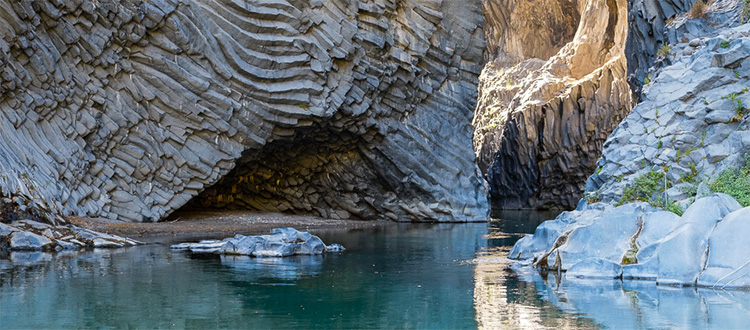Alcantara Valley Gorges
Alcantara Valley Gorges
These are gorges up to 25 meters deep and 2 meters wide at their narrowest points and 4-5 meters at their widest points. The natural canyon was not in fact formed through the erosion caused by thousands of years of water. The most accepted hypothesis concerns seismic events. Violent vibrating tectonic movements literally split into two old basaltic lakes dating back 300,000 years, to a pre-Etna era, formed by the leakage of magma through cracks in rock, allowing water from the river to seep inside. This phenomenon is shown by the fact that the structure of the gorge sides (similar in some points to “stacks of wood” and in others to “organ columns”) is intact and jagged.
The Alcantara river flows over the lava stone that forms its characteristic riverbed. In the area around Motta Camastra in Fondaco Motta the most impressive and famous Alcantara gorge is to be found. More than 6 km long, it can be easily explored for the first 3 km.
The peculiarity of this gorge is the structure of the rock walls, created by a flow of basaltic lava rich in iron, magnesium and calcium. The lava then cooled very slowly, as is seen by the great density of the plateau created. Pentagonal and hexagonal prisms were thus created, reminiscent of the molecular structure of materials from which it is formed.
History of the Alcantara Valley
The first evidence of human settlements in the valley date back to the late Copper Age and the beginning of the Ancient Bronze Age (see the necropolis in the Marca district – Castiglione di Sicilia).
After the arrival of the Greeks in Naxos in 735 BC, the early Sicilians were forced further towards the inner parts of the island. Some time after the area of Francavilla hosted a calcidese colony, of which the rich sanctuary of Demeter and Kore (VI century BC.) are remains.
In the year 1060 the Normans began the liberation of Sicily and on Christmas Eve 1130, led by Anacleto II, the kingdom of Sicily was born. The Alcantara valley was considered of vital importance because of its strategic location. Crossed at its interior by a major route between Messina and Palermo, it was later to become the Via Regia.
Alcantara Valley and Its Crafts Tradition
The crafts traditon has always meant high-quality specialized jobs. This is easily seen today in the few shops that still remain. Ideas, creativity, manual dexterity and the skills of local men and women have created items of the highest distinction.
The figures that make Alcantara Valley such a highly-valued area for its crafts tradition are varied. The seamstress, whose imagination brings beautifully-crafted garments to life. The embroiderer, whose patience is able to create fine works that today have considerable economic value. Finally the spinner.
Crafts more typically (and traditionally) masculine are those related to the skills of the shoemaker and the blacksmith. Finally let us not forget the sculptor, from whose imagination, and with the aid of a chisel, stone or wood take on their desired shapes.



